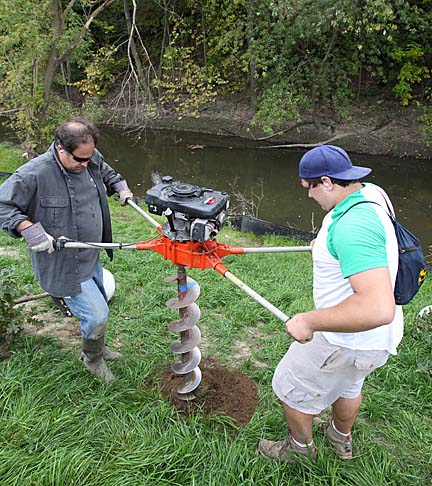
Tim Bowlin, left, and Patrick Cisek used an auger to dig holes to plant trees along the Ottawa River. They were two of 25 volunteers who helped put in more than 300 native trees and plants earlier this month as part of the restoration project sponsored by the President’s Commission on the River.
The project team, including the President’s Commission on the River, Toledo Metropolitan Area Council of Governments and the U.S. Army Corps of Engineers, will present plans and field questions about phase two of the restoration.
In 2009, the commission started the habitat restoration efforts for the 3,700 feet of the waterway that runs through Main Campus. Funding the current work is a $235,000 grant from the Ohio Environmental Protection Agency and a $111,000 grant from the U.S. Fish and Wildlife Service.
“A variety of techniques using natural materials — rocks, logs and wood — will be used to create changes in the river flow and to enhance the aquatic habitat and provide shelter for fish and aquatic organisms,” said Dr. Patrick Lawrence, professor and chair of the Department of Geography and Planning, and chair of the President’s Commission on the River.
In natural streams, water flow varies and has more movement and diverse materials, he said. Right now, the river is flat and there are no changes to the way the water moves.
Phase two of the Ottawa River restoration calls for recreating nature in various ways in five sections of the waterway.
Riffles — short, shallow areas of stream that increase the speed of water flow — and large cover stones will be installed. Locked logs and aquatic plantings also will assist with water movement. Lunkers — cave-like spaces beneath the banks — for fish will be built. Cut banks and grade work also will be utilized to create areas for water storage as in-stream elements are added, as well as to control for erosion.

Casey Kimball, left, and Shawna Bessette planted a tree earlier this month as part of the Ottawa River restoration project.
The project will serve as a demonstration of ways to restore an urban river. And it will mean more fish and wildlife, Lawrence said.
“We want to attract more fish and critters fish eat, and improve the diversity of plants and other animals that call the river home,” he said. “Forty species of fish already have been identified in the Ottawa River, but we want to do much better and have an improved aquatic habitat for plants and animals.”
Phase two restoration plans will be finalized in early 2013, with the in-stream and associated bank work, including the addition of native plants, slated to begin next summer.
Recent work on the project included adding a cut bank south of the Law Center to allow for more water storage during potential higher river levels. And earlier this month, more than 300 native plants and trees were put in along the banks of the river.
“We hope to improve the condition of the Ottawa River on campus while educating the UT and local communities about what can be done with urban streams,” Lawrence said.
Free parking for the meeting is available in Lot 10, located north of the Glass Bowl.
For more information, contact Lawrence at patrick.lawrence@utoledo.edu or 419.530.4128.